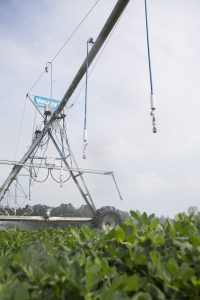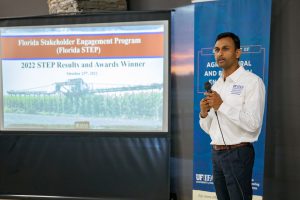The Impact of Water Movement
Water is always going someplace. Rivers and rain – these are obviously water in motion, but even in a lake, as placid as it may seem, water is on the move, exiting through rivers and creeks and up into the air. Even where we do not see water, it is usually moving underneath us through the ground. As water moves, many things hitch a ride, for example, beverage cans, plastic water bottles, and other litter. These are important concerns, but just as important are the invisible hitchhikers – chemicals – that are picked up by water as it washes over our buildings and through our streets and fields. These chemicals can be nutrients, pesticides, and other contaminants, but either way, they can have undesirable effects wherever they go. As Florida’s growth and development continue at a strong rate, it is more important than ever for all users who share Florida’s water – agricultural, industrial, household, recreational, and environmental – to find ways to use water more responsibly.

“Nutrients” generally refers to the fertilizers used in agriculture, landscaping, golf courses, sports fields, etc. that are washed into groundwater, canals, or rivers by Florida’s abundant rain or irrigation water. These nutrients are a benefit to crop production and keep our lawns dense and green, but in natural water bodies, they promote the growth of plants such as algal blooms that can rob lakes and wetlands of their oxygen and begin a process called eutrophication, through which the water body might no longer be able to support life.
The contaminants that water picks up come from many sources. This could include pesticides used in agriculture and in urban landscaping, but it also includes heavy metals, petroleum products, small particles, and other contaminants. Industrial waste often finds its way into runoff, and it can contain many varieties of pollutants. Sewage can also find its way into runoff. Many of these substances have an adverse effect on plants, animals, and drinking water sources and many are carcinogenic and have long-term effects.
The Quest to Increase Agricultural Water Use Efficiency
The sources of contaminants can be difficult to determine, but one opportunity to reduce nutrient transport from agricultural fields is the precision application of water and fertilizers in agricultural operations. This is the problem that Dr. Vivek Sharma is working to solve. Dr. Sharma is an assistant professor in the Agricultural and Biological Engineering Department who specializes in precision water management. His focus is agricultural water use, and he wants to increase the efficiency of water use in agriculture, reduce agricultural water use overall, and reduce the impacts of agriculture on water quality. Accomplishing these goals means applying a wide range of high- and low-tech solutions to many different crops that are grown in Florida’s various regions. That keeps Vivek quite busy as he presents and demonstrates new technologies and practices to producers and supports them in adopting these methods.
An important technology that can apply to all crops is the soil moisture sensor, which provides real-time soil water information on a user’s computer, tablet, and phone to guide when water is needed and – more importantly – when it is not. To this end, Vivek is providing leadership on Florida Agricultural Soil Moisture Sensor Network to educate producers and Extension personnel in using the information the sensors provide to reduce water use while preserving crop productivity. The project is funded by Florida Department of Agriculture and Consumer Services (FDACS) – Office of Agricultural Water Policy (OAWP) and bringing cultural and behavioral changes in technology implementation resulting in water conservation, nutrient, and energy savings. These savings in water and in dollars for the producer can be impressive. One corn grower reduced the water used for one year’s corn crop by 290 million gallons! Vivek cites not only water savings – another large grower saved $45,000 in diesel fuel and $8,000 in fertilizer savings by using the soil moisture sensing technology. This is the difference between typical irrigation practice and precision water management. Considering the narrow profit margins of agricultural production, savings like this are significant, not to mention the positive impact on the environment downstream from these operations. Consider also that when producers use less water, they are washing away less fertilizer, saving dollars and washing fewer nutrients into Florida’s waterways. Multiply these savings across the 47,000 farms in Florida and imagine the impact of this one technology.
Vivek is also working with a cooperative project between The Nature Conservancy (TNC) and the University of Florida to place more of these probes and the software that goes with them as well as train producers in their use. As each of these efforts produces more data and more success stories, more producers will see the value of adopting soil moisture sensor technology.
Florida Agricultural Stakeholder Engagement Program (STEP)

Several best management practices (BMP) for water and nutrient are being implemented across Florida. To help demonstrate and promote this technology and the effective implementation and use of Best Management Practices (BMPs), Vivek initiated the Florida Agricultural Stakeholder Engagement Program (STEP). The main aim of the STEP is to incorporate and engage producers, industry, agricultural research, and agricultural technology in an interactive real-world system through a farm management competition focusing on productivity, input use efficiency, and profitability. This program gives producers hands-on experience with new technology in a no-risk environment where they can interact with other producers and specialists. STEP provides an enriching experience that fosters “action-oriented learning,” adoption of best management practices (BMPs), and camaraderie among producers, industry representatives, Extension specialists, and researchers.
The program funded by FDACS-OAWP, started with a kickoff meeting at the North Florida Research and Education Center–Suwannee Valley at Live Oak in spring 2022. Participating teams (individuals and/or groups; 11 teams with 29 participants in the 2022 edition) compete as farms in the production and marketing of a corn crop. Competitors make production, management, and marketing decisions for the growing season, and Vivek’s project team implements them in the field. Decision choices include crop insurance coverage, crop variety, planting density, irrigation amount and timing, nitrogen fertilizer amount, timing, and method and marketing.
These decisions are made under conditions that closely reflect those of an actual farm business and are submitted in real-time using a password-protected website (https://step.ifas.ufl.edu/).
In addition to projects to reduce water inputs (and outputs) in agriculture, Vivek is also part of a project to effectively manage fertilizer inputs in agriculture using the “5R” principle of fertilizer management i.e., proper fertilizer source, placement, rate, and timing with effective irrigation being the 5th R. The cost of fertilizers, which are made in part using natural gas, has risen steadily in recent years because of the increasing demand for natural gas for generating electricity. In this FDACS-OAWP funded project, Vivek and his colleagues are investigating the use of controlled-release and conventional fertilizer in corn, carrot, potato, and watermelon crop and their respective impacts on water quality using in-field data collection and modeling tools. This is an on-going project that has great promise. Watch Vivek’s Twitter feed for updates: @VivekSharmaUF.
These projects are representative of Vivek’s high level of activity in pursuing his goals, and they are already making a difference. Vivek’s work and its impact on Florida agriculture were recently acknowledged when he was named Outstanding Young Extension Worker for 2022 by the Florida Section of the American Society of Agricultural and Biological Engineers. They cited his work with the Florida Agricultural Soil Moisture Sensors (SMS) Network, the Florida Agricultural Stakeholder Engagement Program (STEP), his many publications and articles as well as over 100 presentations and, more. This award is the latest in a series that have recognized Vivek’s accomplishments in addressing one of the biggest challenges facing Florida and ag producers around the world.
That’s UF ABE: Big Questions, Global Reach.
This article was written by: Charles Brown
 1
1


